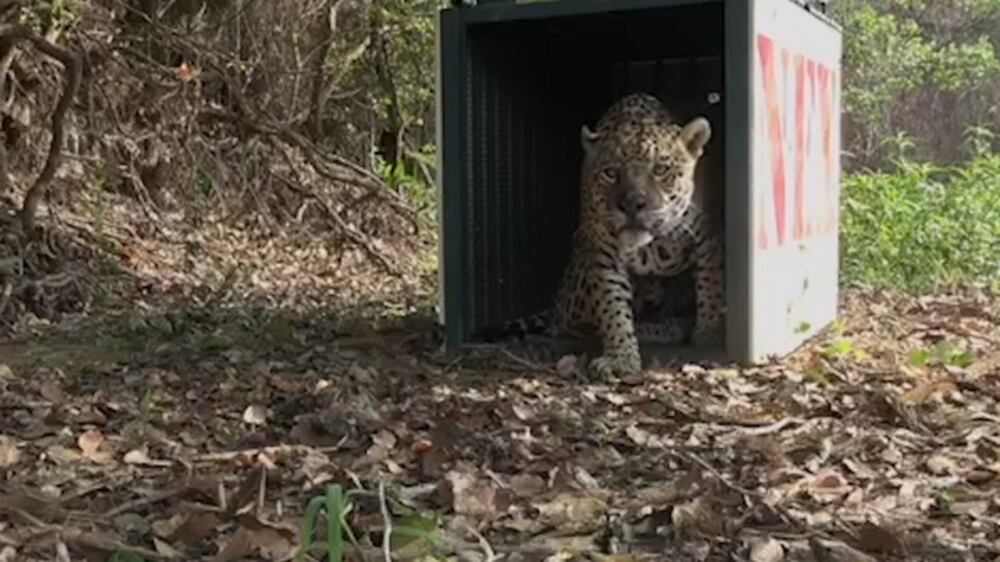It’s been weeks since flames first licked through the now-charred region of the Pantanal that Fernando Tortato and a team of volunteers are slowly scouring through.
A jaguar programme conservation scientist with Panthera – the global wild cat conservation organisation – Tortato has joined government agency workers and local volunteers to comb through the blackened remnants of the world's largest tropical wetlands, after they were ravaged by the worst fires on record. The task at hand is grim.
The group are on a death walk. Quite literally, traversing countless kilometres of singed open marshes in an effort to count the dead animals and corpses left behind by the flames.
“It’s a huge effort, but we are trying to estimate the number of animals killed by fires in the Pantanal this season,” explains Tortato. The data collected will help researchers determine the effect of the wildfires on the region's unique biodiversity.
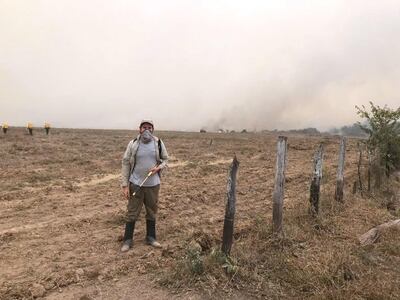
Almost 50 times the size of Dubai, the Pantanal spans the Brazilian state of Mato Grosso do Sul, spilling into Mato Grosso, Bolivia and Paraguay. While the region may not be as well-known as its nature-blessed sibling, the Amazon, it's a sought-after destination with ecotourists, who flock to the wetlands for their high concentration of wildlife. The Pantanal has just the right conditions to make it home to some of the world's largest populations of jaguars, tapirs, marsh deers, giant armadillos, anteaters, giant otters and more.
But this year's fires could change that. A blaze that started in Bolivia in August was driven hundreds of miles east by high winds and an extra-long dry season. The flames eventually reached the Patantal, where they scorched over one million hectares and wiped out plants, animals and natural habitats.
According to those monitoring the devastation, the worst affected by the flames have so far been smaller animals – tree frogs, swamp snakes and turtles, all of which have been disproportionally culled. Animals that rely on the region's scant water supplies – caymans, anaconda and the like – have also been devastated. And the teams have stumbled across the burnt carcasses of coati, anteaters and capybara as they trudge over the remains of what should be a natural wonder.
Tortato, who is typically based at the 24,000-acre Jofre Velho Ranch, a critical link in Panthera’s Jaguar Corridor Initiative, believes the worst may be yet to come.
“The jaguars aren’t as badly affected by the fires at first because they can run and escape them. But it’s a process. The fires kill the trees, the vegetation and all the small animals, so that even if the jaguars survive the fires, they no longer have anything left to eat – and so they will just die anyway. It’s very sad."
Gloria and Ousado: jaguar rescues stories
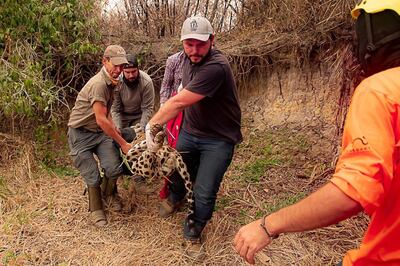
That's not to say that the big cats have escaped the wandering flames unscathed. Panthera now estimates that more than 600 jaguars have been displaced, injured and or killed by the fires raging across the wetlands.
Tortato has been involved in several major jaguar rescue operations. One of these was for Gloria, a female jaguar found with third-degree burns on her paws. Another was Ousado – a five-year-old male with scorched paws that the team picked up by a river in the Encontro das Aguas nature reserve.
After 36 days of intensive stem-cell treatment at the NEX Institute, a Brazilian NGO that defends endangered wild cats, Ousado was successfully returned to the wild on October 19. Sadly for Gloria, a return to her home is unlikely. Although she’s been rehabilitated by veterinary teams, the damage to her paws and tendons mean she can no longer extend her claws, so could not fend for herself in the wild.
The death walks are just one unexpected role that Tortato has taken on since arriving back in the Pantanal this year. His expectation when he first arrived was that he'd continue his ecotourism research.
As well as setting up camera traps to record jaguar movements and speaking to tourists who come to see the cats, he also planned to dedicate a large portion of his time to fostering relations between the locals, who use the land for cattle ranching, and those who rely on the tourism dollars it can bring. But as soon as he reached the ranch, the researcher realised his plan had to change.
“I knew that there were some fires,” says Tortato. “I thought they were normal and that a bit of rain would control them. But when I arrived and looked around, I instantly knew it was different. The fires were a lot bigger and I knew I had to temporarily retire from my researcher position and take up a role as a firefighter."
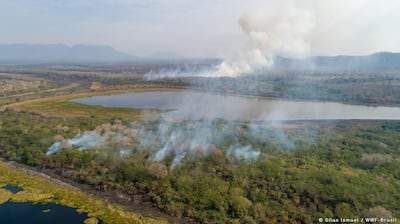
As he joined locals, environmental agency workers and volunteers to try to control the flames, there was initially a sense of hope. After hours battling fires on a neighbouring ranch, the group gained some sense of control over the blaze, effectively slowing its path. Spurred by this, they created a plan to try to construct fire breaks and bridges that would function to isolate the Panthera ranch.
“We did the work and we waited. When the flames grew close to the fire break, we battled, fighting to control the fires,” recalls Tortato. “But, at some point, we simply lost control – there were just too many places where fires were breaking out. At one point, in a very remote area – the fires seemed to almost jump from one side of a river to the other, and with that we lost the battle."
The effort was not entirely in vain – the work preserved an area of the ranch spanning almost 2,000 hectares, a place that is now an important refuge for the region's wildlife.
“I was looking at the Nasa maps that show the locations of the fire and I knew that they were growing and spreading rapidly, but it's impossible to just stand there and look at it without taking any action. Especially when the local people are there putting in an insane effort. They stay there many days, often 24 hours a day firefighting."
One of the most difficult factors for researchers working in the Pantanal today is to try to determine whether the scale of this year's fires are a one-off, or if it’s the way of the future.
“I hope that it’s just this year and that next year we will return to smaller fires, but there are so many examples around the world that indicate that it's more likely that this is how things are going. It's an effect of climate change, and that’s where the problem lies, because it will have a long-term effect on the general population and biodiversity across the entire Pantanal."
Ecotourism in the Brazilian Pantanal
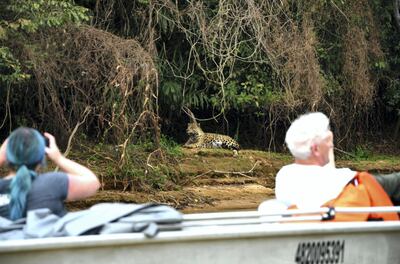
For some of the locals, this cycle isn't new. "The older men of the Pantanal will tell you that sixty years ago the land here was as dry as it is now, but we don’t have much data from then, so it’s hard to compare," explains Tortado. But he does have research and data when it comes to the region's ecotourism.
Tourist numbers in the Pantanal have been growing in recent years as people sought out its unique landscape as a prime place to view animals in their natural habitats. “It's easy to see deer, peccaries, jaguars and many other species, all in the same trip," says Tortato.
"If you spend a week in the Amazon, it's possible that you can see one or two species, mostly monkeys. But in the Pantanal, you can see dozens of species and that’s what makes it such a prominent area for nature tourists."
This year, uncontrollable fires are not the only factor decimating the region's tourism industry. Travellers had already cancelled trips due to the outbreak of the coronavirus and its rapid spread across Brazil. The country's borders were closed in March for almost five months. With tourism now back on the cards and entry restrictions eased, travellers continue to stay away. As the third hardest hit country in the world with more than 5 million confirmed cases of Covid-19, international tourists are simply not ready to risk a visit.
The impact of the global pandemic
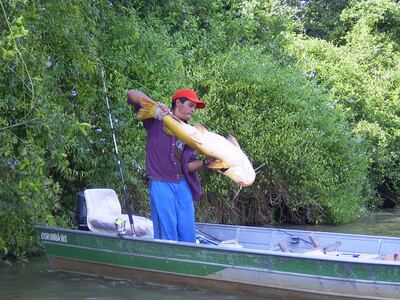
“It’s been very hard, because jaguar tourism is typically made up of 97 per cent foreign tourists and only 3 per cent Brazilians," says Tortato. "Without international visitors, lodges are empty, tours are cancelled and tour guides have no income."
However, a small sliver of hope prevails. “We have actually seen an increase in local tourists coming to the region, not for nature or ecotourism but for fishing expeditions,” reveals the researcher.
Brazilians from across Mato Grosso and Goias who would typically take a flight north to enjoy the country's beaches or fly down to Sao Paulo for the summer are instead looking to holiday a little closer to home.
“The Pantanal has become an attractive place for families to drive to and take a short trip, do some fishing and maybe stay for the weekend. This year, we have seen a definite increase in the numbers of local tourists, and that’s good for the community as it provides some jobs.”
While domestic tourism is never going to replace international tourism, it's a beacon of hope in a region that has battled one of its harshest ever seasons. Guest lodges located along the riverside have been able to remain open, albeit often with low occupancy levels.
"Everyone is trying to work hard so that we can bring tourists again next year. Where they can, people have maintained the tours that were cancelled this year and simply moved the dates to next year," explains Tortato.
In the last week, rains finally showered the Pantanal, putting out the majority of the fires and allowing Tortato to get back to his work in ecotourism and research. A fellow researcher told the scientist that he had collected data about the rains on his ranch which showed that two years ago, the gap between the last rain in March and the first rains to fall in September was just over 80 days. The following year, that drought increased to 120 days and this year, it was more than five months before the rains came.
With the fires quelled for the moment, the Pantanal can start dealing with the smoggy hangover it's left with. And while the world's largest tropical wetlands will survive this year's devastation, and maybe even another one, this ecotourism gem cannot survive such destruction indefinitely.
